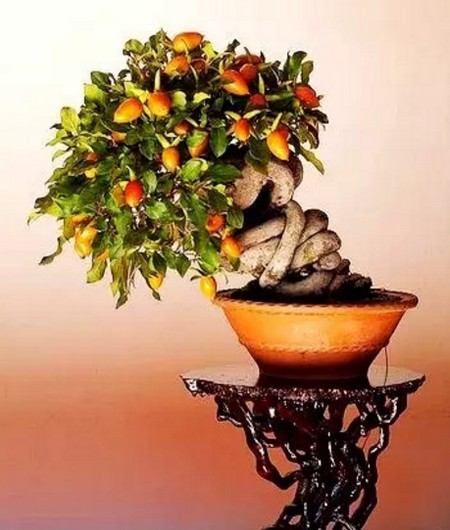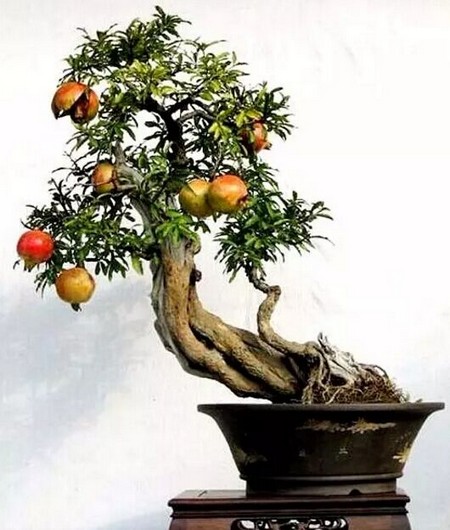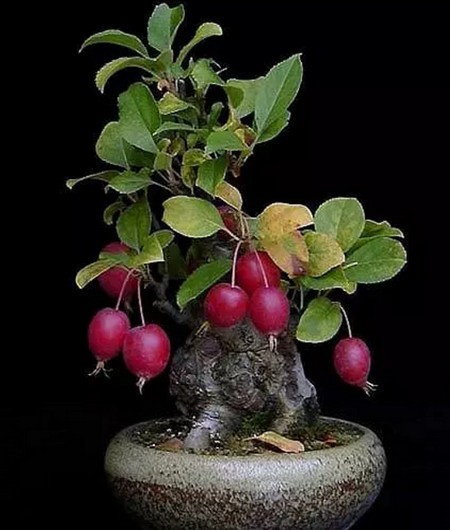Growth characteristics of bonsai branches of fruit trees
Branch is an important part of crown and tree shape. It not only produces leaves, flowers and fruits, transports water and nutrients, but also plays an important role in nutrient storage. Sturdiness and sturdiness is an important guarantee for potting trees to bear fruit year after year.
Some fruit tree branches can produce adventitious roots under suitable conditions, such as grape, citrus, lemon, pomegranate, fig and so on.
Branches can be divided into vegetative branches (growing branches) and fruiting branches. Those with only leaf buds are vegetative branches. This kind of branch generally grows strong, the bud is full, and can form the skeleton of the tree. Bearing flower buds or regular mixed flower buds and leaf buds are fruiting branches. The number of fruiting branches determines the yield of potted trees, therefore, unfruited trees should cultivate enough fruiting branches as soon as possible, and fruiting trees should cultivate strong fruiting branches while raising good fruit, so as to ensure flowering and fruiting in the following year.

The branching order has a direct effect on the growth and fruit. The young apple trees with few branches grow vigorously and are difficult to form flowers. Pruning and grafting, increasing the branch order and relaxing the growth potential are important ways for early flowering and early fruiting.
The ability of buds to germinate into branches is called sprouting power. The ability to pull out growing branches after sprouting is called strong branching ability and branching ability, and can form a satisfactory tree shape in the same year, while Hawthorn is weak; the same tree species has strong branching ability in young trees and weak branches in older trees. According to this characteristic, in pruning, more branches should be thinned to reduce the number of branches with strong sprouting and branching power, and on the contrary, they should be cut more short to promote branching, so as to adjust the shape and quantity of branches.
The apical advantage of the branch is that the terminal bud or stem tip often inhibits the germination and growth of the lower lateral bud, and the branch formed by the terminal bud germination is the strongest, weakening downward and even unable to germinate. Removal of apical bud or tip could promote lateral bud germination and lateral branch growth, but the first lateral bud at the top still maintained apical dominance.
The vertical dominance of branches showed that the upright branches grew vigorously, the oblique branches grew weaker and the branches increased, while the horizontal or drooping branches grew less, and the branches became shorter and weaker. In addition, after pulling the branches, the upper dorsal branches or buds growing upward in the twisted parts of the branches are very easy to germinate and grow.
By making use of the top advantage and vertical advantage, the crown can be expanded rapidly and shaped purposefully. However, the resulting strong branches often make the shape rate of dwarf pots chaotic, especially for molded trees and fruiting trees must be strictly controlled. Methods such as changing the direction and angle of branches, picking hearts in time or even thoroughly dredging them can be adopted to prevent the situation of "growing trees on trees" and overflourishing trees, only growing branches and leaves without flowers and fruits.
The relationship between branch growth and fruit shows that the unfruited tree grows vigorously; once it bears fruit, the growth potential of the branch weakens and the crown size is easily controlled; excessive fruiting, the branch growth weakens, the proportion of short branches increases, and the flower branch decreases.
The relationship between branch growth and rootstock is also very close. When the same variety of the same tree species was grafted on the Arbor rootstock, there were significant differences in the growth potential, growth duration, number of branches, the ratio of long and short branches and the occurrence of flower buds. Therefore, although the varieties are the same, but the rootstocks are different, the technical management measures should be different accordingly.
In addition, the growth of branches and the use of pots have great influence. The big basin is not only nutritious, but also has a large root system, which shows strong branches. As the root growth keeps a certain balance with the aboveground growth, reducing the root volume can also effectively control the vigorous growth. The smaller the pot, the shorter the growth of the branches, the slower the thickening of the branches, and the easier it is to control the size of the crown.
Time: 2019-05-25 Click:
- Prev

Characteristics of Root System of Fruit Tree Bonsai
Potted fruits and vegetables have long flowering period and beautiful shape, which can not only play the role of greening, but also add more interest than greening. When placed indoors, you can enjoy the whole process of fruit and vegetable flowering and fruiting in a long time. Potted fruits and vegetables have both summer varieties planted in the open air and winter varieties planted in greenhouses and greenhouses
- Next

Growth characteristics of bonsai leaves of fruit trees
Bonsai fruit trees set to view the shape of trees, enjoy good color, taste fresh fruit in one. Trees need to bear a certain number of fruits, and the shape, distribution, size, number, color and leaf-fruit ratio of fruits are all important factors that constitute the bonsai art of fruit trees. Bonsai of some fruit trees have not only ornamental value, but also edible fruit.
Related
- Fuxing push coffee new agricultural production and marketing class: lack of small-scale processing plants
- Jujube rice field leisure farm deep ploughing Yilan for five years to create a space for organic food and play
- Nongyu Farm-A trial of organic papaya for brave women with advanced technology
- Four points for attention in the prevention and control of diseases and insect pests of edible fungi
- How to add nutrient solution to Edible Fungi
- Is there any good way to control edible fungus mites?
- Open Inoculation Technology of Edible Fungi
- Is there any clever way to use fertilizer for edible fungus in winter?
- What agents are used to kill the pathogens of edible fungi in the mushroom shed?
- Rapid drying of Edible Fungi

